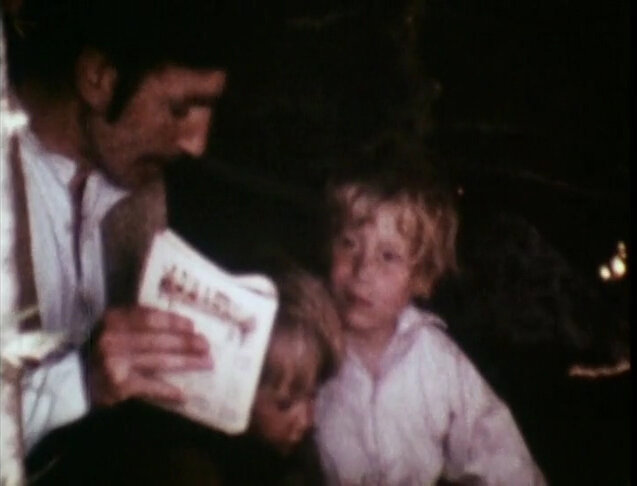COILIN AND PLATONIDA
UK | 1976 | colour | 85 mins
Credits:
Filmed On Super 8 In Connemara, Co. Galway, Ireland
Based On The Story, Kotin & Platonida By L.S. Leskov
Director: James Scott
Producer: Eckart Stein, Das Kleine Fernsehspiel, ZDF television Germany
Actors:
Coilin As A Young Man - Coilin O Finneadha
Platonida - Frankie Allen
First Orphan Child - Alexander Scott
Second Orphan Child - Rosie Scott
Production Unit:
Photography - Joe Comerford
Re-filming - Adam Barker-Mill
Helen Richardson
Anna Scott
Carolyn Tipping
Song: 'Una Bháná’, sung by Máire Áine Ní Dhonnchadha
Piano: Composed and played by Rod Melvin
Acknowledgments:
Berwick Street Film Collective
Herman’s Hair Care
Salthill Hotel, Galway
Synopsis
Coilin and Platonida is based on a nineteenth century Russian story by Nicolai Leskov, but adapted by Scott to an Irish setting. Coilin and Platonida tells of a boy raised as a girl until the age of twelve and his cousin, a girl Platonida, who is unhappily married and disappears after being sexually attacked, giving rise to a legend.
Shot in an isolated community in Connemara on the west coast of Ireland, with a cast of local non-professionals, the film uses this strange, ambivalent folk story as a spring-board for an exploration of “the connection of sign or symbol with the external reality and theme by which photography or film can penetrate beneath the everyday surface of reality.”
Coilin, as an adult, adopts two children. Platonida is married to the son of a rich landowner and lives in a large house. One night she is attacked and while attempting to defend herself, kills her attacker.
The film is about the process whereby we understand an image and how we derive knowledge from that image. How does personal experience through time become a legend and a means of wider illumination?
Filmed in super-8 and re-filmed on 16mm, the footage is completely re-invented. “The colour and texture are carefully and beautifully controlled, yet vibrant.” (1) A piano piece, composed and played by Rod Melvin, accompanies the film and is punctuated by a haunting Gaelic song.
Notes
(1) Deke Dusinberre, TIME OUT n. 344 oct 22 1976
REVIEWS:
From Sight and Sound:
Jonathan Rosenbaum’s Ten Best Films of 1976
1. Shin Heike Monogatari (Kenji Mlizoguchi)
2. Five Women Around Utamaro (Kenji Mlizoguchi)
3. Sansho Dayu (Kenji Kenji Mlizoguchi)
4. Numero Deux (Jean-Luc Godard)
5. Celine And Julie Go Boating (Jacques Rivette)
6. Family Plot (Alfred Hitchcock)
7. F For Fake (Orson Welles)
8. Coilin and Platonida (James Scott)
9. Breaking With Old Ideas (Peking Film Studio)
10. Eadweard Muybridge, Zoopraxographer (Thom Andersen)
ZDF’s Kleine Fernsehspiel series this time offered us something very remarkable: a silent film shot on 8mm colour stock by James Scott, in which only now and again a high pitched Irish female voice broke into lamentation. It was as though some ancient myth had been transcribed from a prehistoric cave painting. The story of Coilin and Platonide is a primal fable whose deeper meaning stays hidden. A film filled with unclear images of a bizarre and enigmatic beauty. We by now have almost lost the ability of allowing ourselves the leisure necessary for an experience like this. Those who persevered were most compellingly rewarded.
-Tagesspiegel Berlin 7.2.76
James Scott’s film, “Coilin and Platonida”, not only keynotes a new kind of feeling in film, but also, in its enigmatic way, brings into focus a very special kind of filmmaking, James Scott, himself. I say enigmatic because, through Scott, the film simplifies complexities without the appearance of strain or pretense. The modes employed by Scott flow into each other to shift space, time and tone; to generate spontaneous feelings. The film is a fable, and fables move through their own time, always arriving at points, and traveling through points, where the sense is so definitely clear. Clarity because it feels clear. However, the terrain which is covered is highly complex and, if one dares to analyze this terrain, one could fall into the holes of contradictions and even find illogical points. But this is the true nature of the fable, if not the true nature of storytelling and image-making, which James Scott has managed to introduce into filmmaking.
Scott is indigenous to film and is intensely concerned and prolific with it. Even with the different topical subjects employed in each of his films, he still sustains that sense attributed to ‘the fable’. He is able to work through the web and labyrinth found in each film. This highlights the essence of both him and his films: that he is able to work through the very matter of his materials and subjects and still consistently render meaning and feeling to them with a rare, solid simplicity. To do this, is brilliance; and to say (with feeling) in film terms, what is needed to be said, is skill.
A criterion for a good film is that what is being said can only be done by the film itself. Scott hits this mark. He makes visually tangible and sensible those very same complexities which he strips away. Scott seems to be saying: ‘’realization’ is only at the point of seeing”, and this he does so well – be it Love’s Presentation, Adult Fun, and most expressly, with Coilin and Platonida. This is far from accident. It is a reflection of a profound, serious talent, and it exists because behind it is the deep concern for the grain of the film to the center of the subject. The strength of Scott’s films lies in his ability to transfer his extensive concern into film without any pretense. The same applies to the viewing of any of Scott’s films: they must be viewed without any pretense. It works like magic.
-Steve Dwoskin, March 1978
